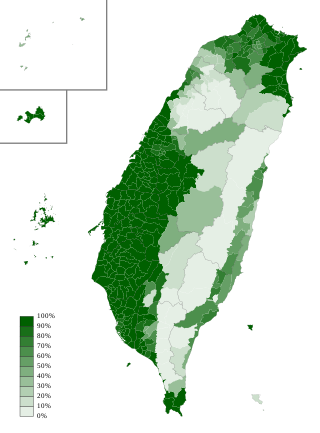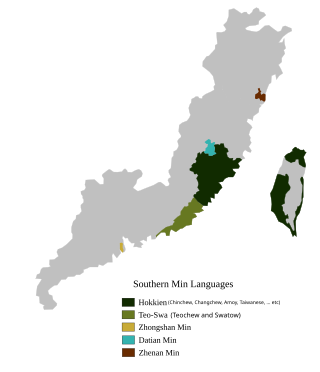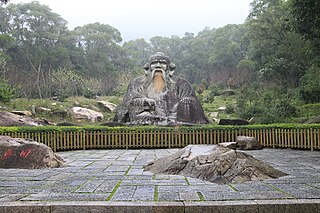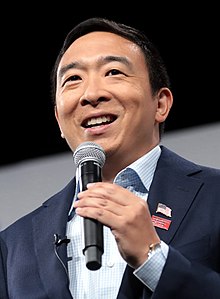
Taiwanese Hokkien, or simply Taiwanese, also known as Taiuanoe, Taigi, Taigu, Taiwanese Minnan, Hoklo and Holo, is a variety of the Hokkien language spoken natively by more than 70 percent of the population of Taiwan. It is spoken by a significant portion of those Taiwanese people who are descended from Hoklo immigrants of southern Fujian. It is one of the national languages of Taiwan.

Southern Min, Minnan or Banlam, is a group of linguistically similar and historically related Chinese languages that form a branch of Min Chinese spoken in Fujian, most of Taiwan, Eastern Guangdong, Hainan, and Southern Zhejiang. Southern Min dialects are also spoken by descendants of emigrants from these areas in diaspora, most notably in Southeast Asia, such as Singapore, Malaysia, the Philippines, Indonesia, Brunei, Southern Thailand, Myanmar, Cambodia, Southern and Central Vietnam, San Francisco, Los Angeles and New York City. Minnan is the most widely-spoken branch of Min, with approximately 48 million speakers as of 2017–2018.

Popiah is a Fujianese/Teochew-style fresh spring roll filled with an assortment of fresh, dried, and cooked ingredients, eaten during the Qingming Festival and other celebratory occasions. The dish is made by the people and diaspora of Fujian province of China, neighbouring Chaoshan district, and by the Teochew and Hoklo diaspora in various regions throughout Southeast Asia and in Taiwan, The origin of popiah dates back to the 17th century.

Chinese Filipinos are Filipinos of Chinese descent with ancestry mainly from Fujian, but are typically born and raised in the Philippines. Chinese Filipinos are one of the largest overseas Chinese communities in Southeast Asia.

The Hoklo people are a Han Chinese subgroup who speak Hokkien, a Southern Min language, or trace their ancestry to southeastern Fujian in China, and known by various related terms such as Banlam people, Minnan people, or more commonly in Southeast Asia as the Hokkien people. The Hokkien people are found in significant numbers in mainland China, Taiwan, Singapore, Malaysia, Philippines, Indonesia, Brunei, Myanmar, the United States, Hong Kong, and Macau. The Hokkien people have a distinct culture and architecture, including Hokkien shrines and temples with tilted sharp eaves, high and slanted top roofs, and finely detailed decorative inlays of wood and porcelain. The Hokkien language, which includes Taiwanese Hokkien, is the mainstream Southern Min, which is partially mutually intelligible to the Teochew language, Hainanese, Leizhou Min, and Haklau Min.

Philippine Hokkien is a dialect of the Hokkien language of the Southern Min branch of Min Chinese descended directly from Old Chinese of the Sinitic family, primarily spoken vernacularly by Chinese Filipinos in the Philippines, where it serves as the local Chinese lingua franca within the overseas Chinese community in the Philippines and acts as the heritage language of a majority of Chinese Filipinos. Despite currently acting mostly as an oral language, Hokkien as spoken in the Philippines did indeed historically have a written language and is actually one of the earliest sources for written Hokkien using Chinese characters as early as around 1587 or 1593 through the Doctrina Christiana en letra y lengua china and using the Latin script as early as the 1590s in the Boxer Codex and was actually the earliest to systematically romanize the Hokkien language throughout the 1600s in the Hokkien-Spanish works of the Spanish friars especially by the Dominican Order, such as in the Dictionario Hispanico Sinicum (1626-1642) and the Arte de la Lengua Chiõ Chiu (1620) among others. The use of Hokkien in the Philippines was historically influenced by Philippine Spanish, Filipino (Tagalog) and Philippine English. As a lingua franca of the overseas Chinese community in the Philippines, the minority of Chinese Filipinos of Cantonese and Taishanese descent also uses Philippine Hokkien for business purposes due to its status as "the Chinoy business language" [sic]. It is also used as a liturgical language as one of the languages that Protestant Chinese Filipino churches typically minister in with their church service, which they sometimes also minister to students in Chinese Filipino schools that they also usually operate.

Cài is a Chinese-language surname that derives from the name of the ancient Cai state. In 2019 it was the 38th most common surname in China, but the 9th most common in Taiwan, where it is usually romanized as "Tsai", "Tsay", or "Chai" and the 8th most common in Singapore, where it is usually romanized as "Chua", which is based on its Teochew and Hokkien pronunciation. Koreans use Chinese-derived family names and in Korean, Cai is 채 in Hangul, "Chae" in Revised Romanization, It is also a common name in Hong Kong where it is romanized as "Choy", "Choi" or "Tsoi". In Macau, it is spelled as "Choi". In Malaysia, it is romanized as "Choi" from the Cantonese pronunciation, and "Chua" or "Chuah" from the Hokkien or Teochew pronunciation. It is romanized in the Philippines as "Chua" or "Chuah", and in Thailand as "Chuo" (ฉั่ว). Moreover, it is also romanized in Cambodia as either "Chhay" or "Chhor" among people of full Chinese descent living in Cambodia and as “Tjhai”, "Tjoa" or "Chua" in Indonesia.

The oyster omelette, also known as o-a-tsian, o-chien or orh luak, is a dish of Min Nan origin that is renowned for its savory flavor in its native Minnan region and Chaoshan, along with Taiwan and many parts of Southeast Asia, such as the Philippines, Thailand, Malaysia, Singapore and Indonesia, due to the influence of the Hokkien and Teochew diaspora.
The term "Taiwanese people" has various interpretations. It may generally be considered the people living on the island of Taiwan who share a common culture, ancestry and speak Mandarin, Hokkien, Hakka, or indigenous Taiwanese languages as a mother tongue. Taiwanese people may also refer to the indigenous peoples of the areas under the control of the Government of the Republic of China since 1945, including Kinmen and Matsu Islands that collectively form its streamlined Fujian Province. However, the inhabitants of Kinmen and the Matsu Islands themselves may not consider the "Taiwanese" label to be accurate as they are a part of Fujian and not Taiwan. They have a distinctive identity from that of the Taiwanese; viewing themselves as Kinmenese or Matsunese, respectively, or as simply Chinese.

The languages of Taiwan consist of several varieties of languages under the families of Austronesian languages and Sino-Tibetan languages. The Formosan languages, a geographically designated branch of Austronesian languages, have been spoken by the Taiwanese indigenous peoples for thousands of years. Owing to the wide internal variety of the Formosan languages, research on historical linguistics recognizes Taiwan as the Urheimat (homeland) of the whole Austronesian languages family. In the last 400 years, several waves of Han emigrations brought several different Sinitic languages into Taiwan. These languages include Taiwanese Hokkien, Hakka, and Mandarin, which have become the major languages spoken in present-day Taiwan.
Waishengren, sometimes called mainlanders, are a group of migrants who arrived in Taiwan from mainland China between the Japanese surrender at the end of World War II in 1945, and Kuomintang retreat and the end of the Chinese Civil War in 1949. They came from various regions of mainland China and spanned multiple social classes. The term is often seen in contrast with benshengren, which refers to Hoklo and Hakka people in Taiwan who arrived prior to 1945 who had lived under Japanese rule. The term excludes other ethnic Chinese immigrants and later immigrants from mainland China.

Hokkien is a variety of the Southern Min languages, native to and originating from the Minnan region, in the southeastern part of Fujian in southeastern mainland China. It is also referred to as Quanzhang, from the first characters of the urban centers of Quanzhou and Zhangzhou.
Benshengren, are ethnic Hoklo or Hakka Taiwanese nationals who settled on the island prior to or during the Japanese colonization of Taiwan. Its usage is to differentiate the different culture, customs, and political sentiments within contemporary Taiwan between those who lived through World War II on the island and later migrants from Mainland China, who are known as Waishengren. Hoklo and Hakka people who migrated to Taiwan after 1945, especially those who migrated with the retreat of the Nationalist-Led Chinese Government to Taiwan in 1949 are not included in this term.
Huan-a is a Hokkien-language term used by Hokkien speakers in multiple countries, namely mainland China, Taiwan, Singapore, Malaysia, Philippines, Indonesia, etc. The word itself when dissected means 番; hoan; 'foreign', + 仔; á; 'diminutive noun suffix', but to the ethnic Chinese that settled overseas in Taiwan and Maritime Southeast Asia, it soon came to refer to the indigenous peoples (natives) in the lands where ethnic Chinese are historical immigrants.
Hoklo Taiwanese or Holo people are a major ethnic group in Taiwan whose ancestry is wholly or partially Hoklo. Being Taiwanese of Han origin, their mother tongue is Taiwanese (Tâi-oân-ōe) (Tâi-gí), also known as Taiwanese Hokkien. Due to The Republic of China's national language policy, most are also fluent in Taiwanese Mandarin. Most descend from the Hoklo people of Quanzhou or Zhangzhou in Southern Fujian, China. The term, as commonly understood, signifies those whose ancestors immigrated to Taiwan before 1949. However, most Hoklo Taiwanese did not distance themselves from Taiwanese identity and prefer to call themselves Taiwanese only, since most of them didn't associate themselves with terms like Hokkien, Southern Min (Minnan) or Hoklo. Some Taiwanese optionally identified as Southern Min (Minnan) as well.
Han Taiwanese, Taiwanese Han, Taiwanese Han Chinese, or Han Chinese are Taiwanese people of full or partial ethnic Han ancestry. According to the Executive Yuan of Taiwan, they comprise 95 to 97 percent of the Taiwanese population, which also includes Austronesians and other non-Han people. Major waves of Han immigration occurred since the 17th century to the end of Chinese Civil War in 1949, with the exception of the Japanese colonial period (1895–1945). Han Taiwanese mainly speak three languages of Chinese: Mandarin, Hokkien and Hakka.

Minnan culture or Hokkien/Hoklo culture, also considered as the Mainstream Southern Min Culture, refers to the culture of the Hoklo people, a group of Han Chinese people who have historically been the dominant demographic in the province of Fujian in Southern China, Taiwan, and certain overseas Chinese communities in Southeast Asia, such as Singapore, Malaysia, the Philippines, Indonesia, Myanmar, Southern Thailand, Cambodia, Southern Vietnam, etc.

Hokkien architecture, also called Hoklo architecture or Minnan architecture, refers to the architectural style of the Hoklo people, a Han Chinese sub-group who have historically been the dominant demographic of the Southern Chinese province of Fujian ,and Taiwan, Singapore. This style shares many similarities with those of surrounding Han Chinese groups. There are, however, several features that are unique or mostly unique to Hoklo-made buildings, making many traditional buildings in Hokkien and Taiwan visually distinctive from those outside the region.













